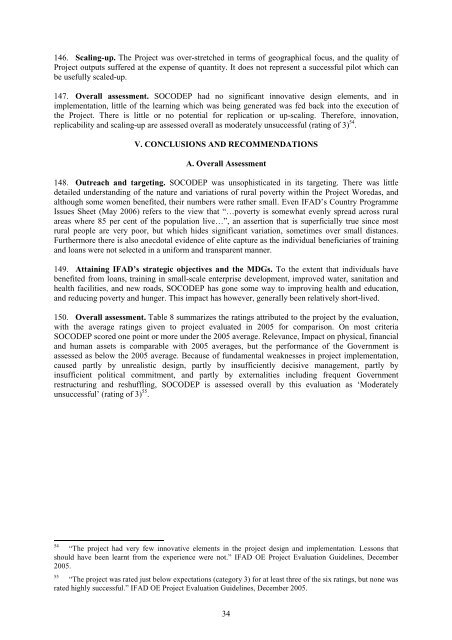Ethiopia SOCODEP CE - main report - IFAD
Ethiopia SOCODEP CE - main report - IFAD
Ethiopia SOCODEP CE - main report - IFAD
You also want an ePaper? Increase the reach of your titles
YUMPU automatically turns print PDFs into web optimized ePapers that Google loves.
146. Scaling-up. The Project was over-stretched in terms of geographical focus, and the quality of<br />
Project outputs suffered at the expense of quantity. It does not represent a successful pilot which can<br />
be usefully scaled-up.<br />
147. Overall assessment. <strong>SOCODEP</strong> had no significant innovative design elements, and in<br />
implementation, little of the learning which was being generated was fed back into the execution of<br />
the Project. There is little or no potential for replication or up-scaling. Therefore, innovation,<br />
replicability and scaling-up are assessed overall as moderately unsuccessful (rating of 3) 54 .<br />
V. CONCLUSIONS AND RECOMMENDATIONS<br />
A. Overall Assessment<br />
148. Outreach and targeting. <strong>SOCODEP</strong> was unsophisticated in its targeting. There was little<br />
detailed understanding of the nature and variations of rural poverty within the Project Woredas, and<br />
although some women benefited, their numbers were rather small. Even <strong>IFAD</strong>’s Country Programme<br />
Issues Sheet (May 2006) refers to the view that “…poverty is somewhat evenly spread across rural<br />
areas where 85 per cent of the population live…”, an assertion that is superficially true since most<br />
rural people are very poor, but which hides significant variation, sometimes over small distances.<br />
Furthermore there is also anecdotal evidence of elite capture as the individual beneficiaries of training<br />
and loans were not selected in a uniform and transparent manner.<br />
149. Attaining <strong>IFAD</strong>’s strategic objectives and the MDGs. To the extent that individuals have<br />
benefited from loans, training in small-scale enterprise development, improved water, sanitation and<br />
health facilities, and new roads, <strong>SOCODEP</strong> has gone some way to improving health and education,<br />
and reducing poverty and hunger. This impact has however, generally been relatively short-lived.<br />
150. Overall assessment. Table 8 summarizes the ratings attributed to the project by the evaluation,<br />
with the average ratings given to project evaluated in 2005 for comparison. On most criteria<br />
<strong>SOCODEP</strong> scored one point or more under the 2005 average. Relevance, Impact on physical, financial<br />
and human assets is comparable with 2005 averages, but the performance of the Government is<br />
assessed as below the 2005 average. Because of fundamental weaknesses in project implementation,<br />
caused partly by unrealistic design, partly by insufficiently decisive management, partly by<br />
insufficient political commitment, and partly by externalities including frequent Government<br />
restructuring and reshuffling, <strong>SOCODEP</strong> is assessed overall by this evaluation as ‘Moderately<br />
unsuccessful’ (rating of 3) 55 .<br />
54 “The project had very few innovative elements in the project design and implementation. Lessons that<br />
should have been learnt from the experience were not.” <strong>IFAD</strong> OE Project Evaluation Guidelines, December<br />
2005.<br />
55 “The project was rated just below expectations (category 3) for at least three of the six ratings, but none was<br />
rated highly successful.” <strong>IFAD</strong> OE Project Evaluation Guidelines, December 2005.<br />
34

















